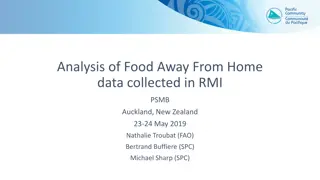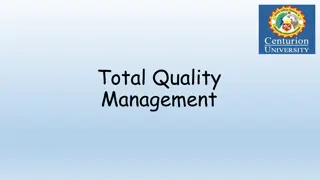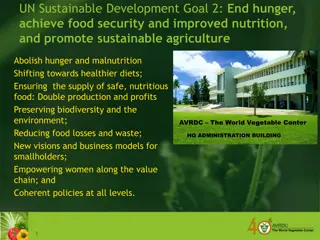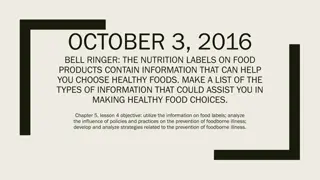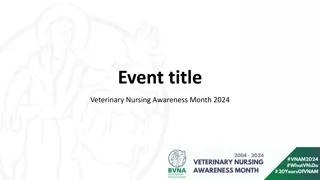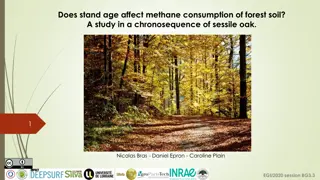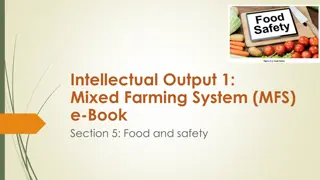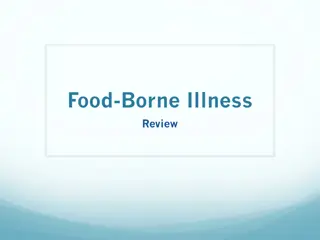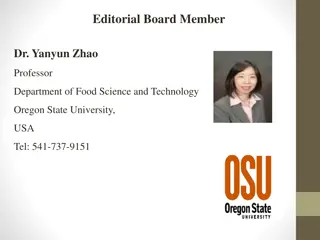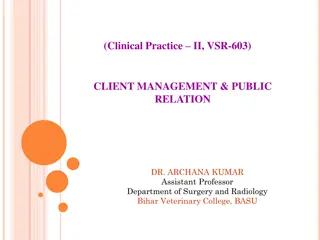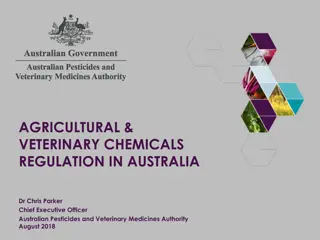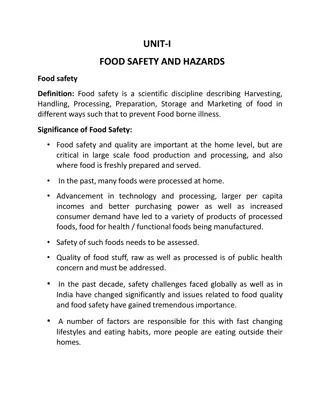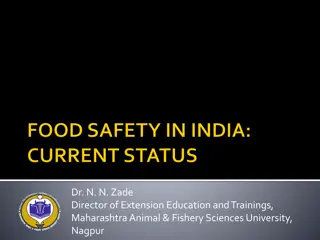Veterinary Public Health and Food Safety: Ensuring Safe Consumption
Introduction to food safety and hygiene, emphasizing the importance of controlling hazards to ensure food fitness for human consumption. Discusses the responsibilities of ensuring food safety and suitability along the food chain, as well as the general principles of food hygiene such as primary production, establishment design, and facilities maintenance. Highlights the significance of environmental hygiene and establishment design in minimizing risks and ensuring food safety throughout the production process.
Download Presentation

Please find below an Image/Link to download the presentation.
The content on the website is provided AS IS for your information and personal use only. It may not be sold, licensed, or shared on other websites without obtaining consent from the author. Download presentation by click this link. If you encounter any issues during the download, it is possible that the publisher has removed the file from their server.
E N D
Presentation Transcript
Unit 1 VETERINARY PUBLIC HEALTH AND FOOD SAFETY (Credit Hours 3+1=4) 1
Food Hygiene is the measures and conditions necessary to control hazards and ensure fitness for human consumption of a foodstuff taking into account its intended use (European regulations). Food hygiene comprises two components: Food safety: is the assurance that food will not cause harm to the consumer when it is prepared and /or eaten according to its intended use. Food suitability: concerns the intrinsic characteristics of the product, namely taste, smell, texture and presentation, characteristics that can change with the presence of spoilage microbes (bacteria, yeast and mould). Suitability is the assurance that the food is 'acceptable' for human consumption. 3
Food safety and suitability must be assured at every link of the food chain 4
General Principles of Food Hygiene Primary production Establishment design and facilities Control of operations Maintenance and sanitation Personal Hygiene Transportation Product information and consumer awareness Training 6
Primary production Environmental hygiene Where the environment/ surrounding poses a threat to food safety. agent used in primary production. Protect food sources from fecal and other contaminant. Hygienic production of Food Sources Control of contamination from air, soil, water, feed-stock, pesticides, veterinary drugs or any other contamination by pests, chemicals, microbiological or physical or other objectionable substances during handling storage and transportation. Cross contamination. Handling storage and transport Use appropriate storage materials and equipment. Protect food and food ingredients from Cleaning maintenance and personal hygiene. 7
Establishment Design and Facilities Nature of operations, associated risks Premises and equipment and facilities to minimize risk and ensure food safety Location: Potential sources of contamination from surroundings. Internal design, structures and layout of the premises rooms and equipment : Should facilitate measures that prevent contamination, durable, movable and capable of being disassembled to allow for maintenance, cleaning, disinfecting and monitoring Facilities especially temporary or mobile facilities : Directly or indirectly impact food safety: water quality, air quality, drainage and waste disposal, temperature control, personal hygiene, lighting, storage ensure effective protection from contamination during storage. 8
Control of Operations Control of food hazards through the use of HACCP system: Potential sources of contamination from surroundings, Time and Temperature. Key aspects of hygiene control systems: Specific process steps, Microbiological and other specifications, microbial cross contamination, physical and chemical contamination. Incoming material requirements: Specification to be identified and applied, where possible inspected and sorted before processing. Packaging: Design and materials used. Water: In contact with food and used as an ingredient Special care for Ice and steam. Management and supervision: Size of the business, nature of activity and type of food. Documentation and records: Period that exceeds shelf life. Recall procedures: Complete recall, handling and communication. 9
Maintenance and Sanitation Cleaning methods and procedures: Appropriate for the type of product and type of machine. Hidden residual food/pest infestation. Cleaning Programs: Method, frequency and monitored for their suitability and effectiveness. Pest Control Systems: Preventing access, preventing harborage and infestation, monitoring and detection, eradication measures. Waste Management: Method, frequency and effectiveness. Monitoring Effectiveness: Periodic Audit, microbial sampling. 10
Personal Hygiene Health Status of Employees. Illness and injuries: Communicable diseases and surface injuries to hands or parts that come in contact with food items. Personal cleanliness: Clothing Personal Behavior Smoking, spitting, chewing and eating, sneezing , personal effects. Visitors Rules and guidelines for entry and access and safety or protective covering. 11
Transportation Design of conveyances and bulk containers. Proper segregation to prevent cross contamination, Time, temperature and humidity controls available and monitored, Appropriate for type of packaging. Use and maintenance. Mixed and prior usage, appropriate scheduling and corrective measures. 12
Product information and consumer awareness Lot identification Codex standard & FSSAI rules Product information Bear adequate information to enable the next person in the food chain to handle, display, store prepare and use the product safely and correctly. Labelling Codex standards and FSSAI rules Consumer education Hygiene, nutrition, label instructions 13
Training Awareness and responsibility Training Programs Nature of food and its ability to sustain growth of harmful micro-organisms. Manner in which food is handled/packed . Extent/Nature of processing or further preparation before final consumption. Conditions under which the food will be stored. Expected length of time before consumption. Instructions and supervisions Refresher Training 14
Food safety management is the application of food policies, systems and processes in a food operation in order to prevent food borne illnesses and protect consumer health. The food safety standards addresses the chemical, physical and biological risks through the use of Good Manufacturing Practices (GMP), Good Hygiene Practices (GHP) and Hazard Analysis Critical Control Point System HACCP. 15






